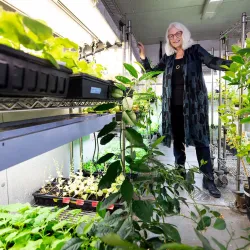Receptors for Neuron Communication in Humans Vital for Reproduction in Mosses
Study shows plant version of human glutamate receptor helps moss sperm find eggs, controls spore development
Glutamate receptors play a central role in the human nervous system. Scientists estimate 90 percent of the human brain’s synapses, or connections between neurons, send signals using glutamate. The role of similar receptors in plants, which do not have a nervous system, is not fully understood.
 A new study led by José Feijó, professor of cell biology and molecular genetics at the University of Maryland, revealed two previously unknown roles for glutamate receptor-like proteins in plants: controlling the navigation of sperm to locate eggs and regulating the development of fertilized eggs. This work was published in the journal Nature on July 24, 2017.
A new study led by José Feijó, professor of cell biology and molecular genetics at the University of Maryland, revealed two previously unknown roles for glutamate receptor-like proteins in plants: controlling the navigation of sperm to locate eggs and regulating the development of fertilized eggs. This work was published in the journal Nature on July 24, 2017.
“Scientists have shown that plants’ glutamate receptor-like proteins play a role in pollen tube growth and defense against pathogens, but we discovered completely novel functionalities for these receptors that no one has ever observed before,” Feijó said. “Since glutamate receptors were thought to act in neural transmission and essentially nothing else, no one knows why plants would have so many copies of these genes. It is very exciting to find that such genes may have been conserved during plant evolution to mediate cell-to-cell communication in sexual reproduction.”
Feijó and his collaborators tested the function of glutamate receptor-like proteins in the moss Physcomitrella patens because it contains only two genes that encode for these proteins. The popular plant model Arabidopsis thaliana, on the other hand, contains 20 glutamate receptor-like genes.
After the researchers removed the two glutamate receptor-like genes from P. patens by mutation, the mosses grew normally, but did not reproduce. The reason: the mutant plants’ sperm did not reach the archegonia, the female organ that contains eggs for fertilization and secretes a chemical signal to attract sperm.
While normal sperm twisted and tumbled and took sharp turns to find the archegonia entrance, mutant sperm swam normally but did not change direction to reach the eggs. In addition, normal sperm could find the archegonia of mutated plants, while mutated sperm could not locate normal archegonia. Together, these findings suggest that sperm require glutamate receptor-like proteins to translate the archegonia’s signal.
“This is important because glutamate receptors are actually present on many non-neuronal tissues in the human body, including sperm, but the reason is unclear,” Feijó said. “Our results suggest one answer, which is that glutamate receptors on swimming sperm may be evolutionarily conserved.”
In some mutant plants, sperm found the archegonia by chance, fertilized eggs and created spores, but the spores died shortly thereafter. The researchers found that the mutant plants did not produce BELL1, a protein needed for development. Supplying BELL1 to the mutant spores led to normal plant development. The results suggest that glutamate receptor-like proteins regulate the production of BELL1 protein, possibly as a second control point of fertilization.
Feijó and his collaborators also investigated how the moss glutamate receptor-like protein might be conducting a signal in plants. They found that it behaves as a channel that allows calcium ions to flow through it. Many human glutamate receptors function in the same way, suggesting that both the plant and the human versions of the receptor conserved this function during parallel evolution.
Going forward, Feijó plans to search for the signaling molecule of the plant receptor, which he believes is not glutamate. In addition, having demonstrated that an important neuronal receptor is related to a receptor in moss, Feijó is enthusiastic about the potential of using plants to study neuronal functions.
“It’s difficult to study these receptors in humans because of the complexity as well as ethical issues,” Feijó said. “But if we can study them in a plant context, we may get answers about fundamental cell biology that could help us understand much more complex functions, such as memory, learning or neurodegenerative diseases.”
###
This work was performed in collaboration with the Instituto Gulbenkian de Ciência (IGC) in Oeiras, Portugal. Other study co-authors affiliated with the UMD Department of Cell Biology and Molecular Genetics include visiting assistant research scientist Erwan Michard, postdoctoral associate Daniel Damineli and graduate student Alexander Simon. IGC-affiliated researchers were Carlos Ortiz-Ramírez, Jörg Becker and Marcela Hernández-Coronado.
This work was supported by the National Science Foundation (Award No. MCB 1616437/2016), the Fundação para a Ciência e a Tecnologia (Award Nos. BEX-BCM/0376/2012 and PTDC/BIA-PLA/4018/2012) and the Marie Curie Initial Training Networks (Award No. FP7-PEOPLE-ITN- 815 2008). The content of this article does not necessarily reflect the views of these organizations.
The research paper, “Glutamate Receptor-like channels are essential for chemotaxis and reproduction in mosses,” Carlos Ortiz-Ramírez, Erwan Michard, Alexander Simon, Daniel Damineli, Marcela Hernández-Coronado, Jörg Becker and José Feijó, was published online in the journal Nature on July 24, 2017.
Media Relations Contact: Irene Ying, 301-405-5204, zying@umd.edu
University of Maryland
College of Computer, Mathematical, and Natural Sciences
2300 Symons Hall
College Park, MD 20742
www.cmns.umd.edu
@UMDscience
About the College of Computer, Mathematical, and Natural Sciences
The College of Computer, Mathematical, and Natural Sciences at the University of Maryland educates more than 7,000 future scientific leaders in its undergraduate and graduate programs each year. The college’s 10 departments and more than a dozen interdisciplinary research centers foster scientific discovery with annual sponsored research funding exceeding $150 million.







